
![[Title fragment 1.1]](t1_1.gif)
|
![[Title fragment 1.2]](t1_2e.gif)
|
![[Title fragment 1.3]](t1_3e.gif)
|
|
|
|
|
![[Title fragment 3.1]](t3_1.gif)
|
![[Title fragment 3.2]](t3_2.gif)
|
![[Title fragment 3.3]](t3_3e.gif)
|
|
Will you go on holiday this year and will you perhaps travel to a foreign country? Possibly you might stumble there across a tiny material sample from a moss cushion. Please keep in mind that some countries do not allow any export of soil and plants at all. And it goes without saying that the landscape shouldn't end up as a partial desert as a consequence of your extensive sampling.We have enjoyed a fine holiday in beautiful Hungary a few years ago. |
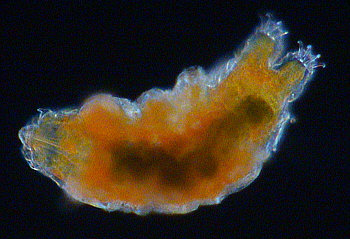 |
Rare tardigrade from Sümeg, Hungary.
|
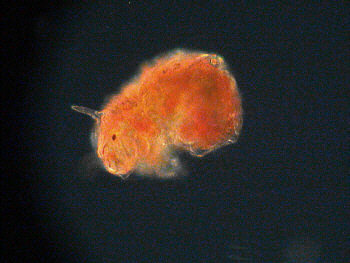 |
Another individuum of the same species.
|
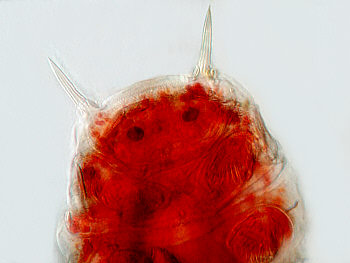 |
Water bear, as before,
|
The two horns can be noticed already by means of a low magnification, so their is no danger that one might overlook those items. |
The first description of a tardigrade with horns goes back to the year 1906. It is only a short note in a scientific journal reporting a lecture by an early tardiologist, Prof. Ferdinand Richters (1849 - 1914) from Frankfurt, Germany: "Prof. Richters showed two ... new Echiniscus species: Echiniscus cornutus n. sp. from the Pfalz region, with hair-like structures on the head which look like daggers and Echiniscus elegans n. sp. with a point-lace armour plate structure."A much more elaborate description was published by Ferdinand Richters a year later, in 1907. This text is kept in a very clear and precise style. If you should be able to read German it might be worth while to order it from your local library. Here we will show by pictures what Prof. Richters explained much better by words: "This species differs from all echiniscus water bears known so far by the structure of the two front-end 'hairs'. Whereas all other echiniscus species have fine hairs in this position, normally less than two microns in thickness (e.g. those of Ech. wendti with a body length of 0.24 mm are 0.125 mm long) we have in this case structures measuring only 36 µ in length but with a width of 6 µ. Broad, dagger-like structures which a botanist might call winged hairs. The central hair structure within can be still perceived and discerned from the wing type processes." |
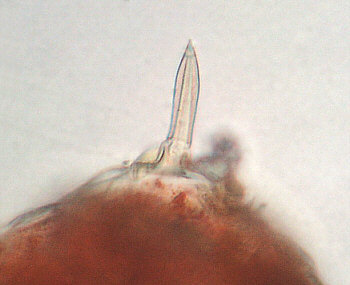 |
One of the horns, in close-up view. Its length is ca. 25 µm. It looks like a dagger, with an inbuilt strengthening structure and it is linked to the shoulder plate by means of a semi-rigid, slim joint. |
Furthermore Richters mentions a characteristic W-shaped structure on the shoulder plate. Original text by Richters (translated): "There is a strange distribution pattern of the grains on (plate) II. In front there is a group of grains separated from the rest by a W-shaped structure. The W spans from one horn to the other; the edges of the W have double contour lines. A medium group of grains is separated from the rear area by a slim line." |
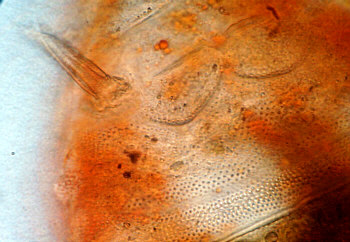
|
W-shaped structure and, below on the same armour plate, a horizontal smooth (non structured) line. |
The typical body posture appears to be a little bit more bent
when compared with other tardigrade species. All individuals from the Sümeg sample
moved very slowly - real tardigrades in the sense of the word.
The percentage of the tardigrades with horns in the overall population
was rather low, there were much bigger groups of eutardigrades,
in particular Ramazzottius oberhaeuseri . |
Literature:
|
© Text, images and video clips by
Martin Mach (webmaster@baertierchen.de).
|